 |
||
| A Collection of Maserati Engines Part I | ||
The contents of this page will enable Maserati enthusiasts and those not so aquainted with this great Marque to see and appreciate the outstanding engineering skills and ingenuity behind Maserati's legendary racing, sports car and GT history. |
| ENGINE TIPO 26 Years of production: 1926-1932 Straight 8-cyl 1492.9 cc engine DOHC with two valves per cylinder Bore 60mm and stroke 66mm Compression ratio 5.8:1 Power output 120bhp @ 5300 rpm Induction system by Roots supercharger No 2 Memini carburettors. |
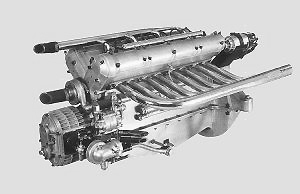 |
|
The legend starts here with the first Maserati engine designed and built by Alfieri Maserati in 1926, the Tipo 26. |
|
| 1928 Tipo 26 MM | 1492.9 cc - 128bhp @ 6000 rpm |
| 1928 Tipo 26R | 1690.7 cc - 140bhp @ 6500 rpm |
| 1929-30 Tipo 26C | 1078.6 cc - 95/105bhp @ 5000/6000 rpm |
| 1930-32 Tipo 26M | 2495.4 cc - 185bhp @ 5600 rpm |
| ENGINE TIPO 26B Years of production: 1927-1930 Straight 8-cyl 1980.5 cc engine DOHC with two valves per cylinder Bore 62mm and stroke 82mm Compression ratio 5.6:1 Power output 155bhp @ 5300 rpm Induction system by Roots supercharger with Memini Super carburettor. |
 |
| ENGINE TIPO V4 Years of production: 1929-1931 V16-cyl @ 35° 3961 cc engine Four OHC with two valves per cylinder Bore 62mm and stroke 82mm Compression ratio 5.5:1 Power output 280/305 bhp @ 5500 rpm Induction system by 2 Roots superchargers No 2 Weber DO carburettors. |
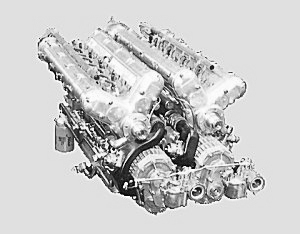 |
|
The V4 (V stood for the cylinder formation and its 4 litre capacity) engine was projected by Alfieri Maserati and designed by Piero Visentini. This engine powered the 1929 Tipo V4 Maserati.
Known as the "Sedici Cilindri" this 16-cylinder was built around two Tipo 26B engines mounted on a common crankcase, with two crankshafts and gearing into a common box.
The various component parts consist of 55 ball races, 27 gears plus 8 gears in the oil pumps, 2 crankshafts, 16 con-rods and pistons, 32 valves, 64 valve springs, four camshafts, two superchargers,
four oil pumps and two water pumps. Both crankshafts run clockwise, driving a central gear which runs anti clockwise. This means the crown wheel and pinion are fitted the opposite way round. |
|
| ENGINE TIPO 4CM Years of production: 1932-1937 Straight 4-cyl 1088.4 cc engine DOHC with two valves per cylinder Bore 65mm and stroke 82mm Compression ratio 5.0:1/6.0:1 Power output 140bhp @ 6800 rpm Induction system by Roots supercharger No 1 Weber 55ASI carburettor. |
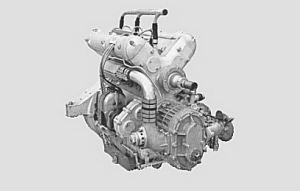 |
|
On the 28th November 1934, this 4CM (4 Cylinder Monoposto) engine was mounted in the streamlined version of the Tipo 4CM, owned and driven by engineer Giuseppe Furmanik, that broke the world record for the flying kilometre for the 1100 cc class at an average speed of 222.634 kph. The previous record of 207.527 kph was held by an MG. |
|
| ENGINE TIPO 6CM Years of production: 1936-1939 Straight 6-cyl 1493.2 cc engine DOHC with two valves per cylinder Bore 65mm and stroke 75mm Compression ratio 6.0:1 Power output 155/175bhp at 6200/6600 rpm Induction system by Roots supercharger No 1 Weber 55ASI (55CDO/45DCO). |
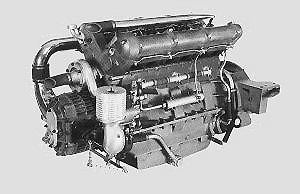 |
|
This engine is a Maserati masterpiece with the cylinder head cast in block
with the heads, paired by twos on a common crankcase in elektron as are the
undercasing and the oil sump. |
|
| ENGINE TIPO 8CL Years of production: 1940-1946 Straight 8-cyl 2981.7 cc engine DOHC with four valves per cylinder Bore 78mm and stroke 78mm Compression ratio 6.5:1 Power output 415/430bhp @ 6400/6800 rpm Induction system by twin Roots superchargers No 2 Memini carburettors. |
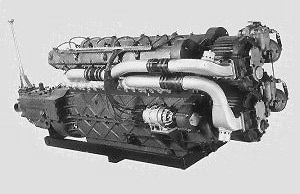 |
|
Derived from the 4CL, the 8CL (8 Cylinder Lineale - 'in a straight line') was composed of two cylinder blocks mounted in line on a common crankcase. Designed between 1939 and 1940, it was the logical evolution of the 8CTF (8 Cylinder Testa Fissa - 'Fixed Head') engine which in those same years (1939 and 1940) powered the 8CTF, driven by Wilbur Shaw, to victory in the 'Indianapolis 500'. This modern supercharged engine, with its four valves per cylinder and equal bore and stroke measurements, was prematurely ended by the outbreak of World War II. After the war, the Grand Prix formula was changed and the 8CL engine, no longer valid for the European races, was raced at Indianapolis by Luigi Villoresi in 1946 and by the American Fred Agahashian in 1949. |
|
| ENGINE TIPO A6 Years of production: 1946-1950 Straight 6-cyl 1488.2 cc engine SOHC with two valves per cylinder Bore 66mm and stroke 72,5mm Compression ratio 7.25:1 Power output 65bhp @ 4700 rpm Induction system by a single Weber 36 DCR carburettor. |
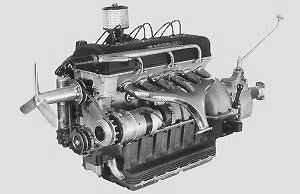 |
|
The A6 (Alfieri 6 cylinder) was the first Maserati engine built primarily for a modern Gran Turismo car and not for racing. First designed in 1941 but not developed until after World War II, this straight-6 single overhead camshaft engine was fitted to the A6 car designed by Pinin Farina. The car had a top speed of 150 km/h and was quite successful commercially with 61 examples (2 in 1946, 3 in 1947, 9 in 1948, 25 in 1949 and 22 in 1949) being built. |
|
| ENGINE TIPO 4CF2 Year of production: 1952-1953 Straight 4-cyl 1994.9 cc engine DOHC with four valves per cylinder Bore 88mm and stroke 82mm Compression ratio 12.0:1/13.5:1 Power output 182/195bhp @ 7000/7500 rpm Induction system by two Weber DBO carburettors Later by direct fuel injection. |
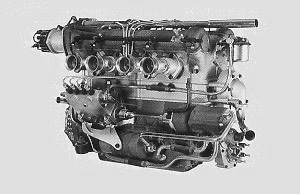 |
|
The Tipo 4CF2 (4 Cylinder Formula 2) was the prototype of an engine designed as an alternative to the 6-cylinder A6GCM engine for the 2-litre Formula. It was an extremely modern design having a crankshaft which could be dismantled but was abandoned in favour of a 6-cylinder engine. In 1953 Maserati engineer Giulio Alfieri tested a direct fuel injection system, supplied by Bosch, with disappointing results. The Tipo 4CF2 represented the last efforts of Alberto Massimino before his departure from the factory. |
|
|
I liked these two paragraphs from Denis Jenkinson's excellent book 'THE MASERATI 250F - A Classic Grand Prix Car'. |
| ENGINE TIPO 250F Years of production: 1954-1958 Straight 6-cyl 2493.8 cc engine DOHC with two valves per cylinder Bore 84mm and stroke 75mm Compression ratio 12.0:1 Power output 240/270bhp @ 7200/8000 rpm Induction system by three Weber 42 DCO3-45 DC03 carburettors (in 1953 also direct fuel injection). |
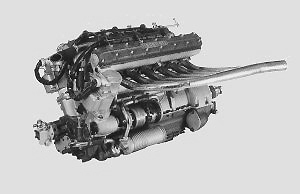 |
|
This engine powered the 250F single-seater with which Juan Manuel Fangio won the 1957 F1 World Championship. The 250F single-seater had a very long and successful race career taking part in all F1 World Championship races from 1954 to 1960, when a change in the regulations for Formula 1 restricted the engine size to 1.5-litres. |
|
| ENGINE TIPO 3500 GT Years of production: 1957-1964 Straight 6-cyl 3485.3 cc engine DOHC with two valves per cylinder Bore 86mm and stroke 100mm Compression ratio 8.5:1 Power output 220bhp @ 5500 rpm Induction system by three Weber 42 DCOE carburettors. |
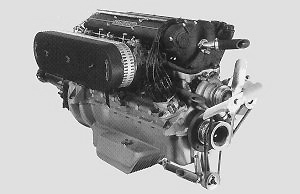 |
|
Following the success of the Tipo 350S in sports car racing,
Maserati took advantage of all their competition experiences by using this engine as the
basis for all Maserati GT car production from 1957 to the early sixties. |
|
| ENGINE TIPO 3500GT Years of production: 1961-1964 Straight 6-cyl 3485.3 cc engine DOHC with two valves per cylinder Bore 86mm and stroke 100mm Compression ratio 8.5:1 Power output 235bhp @ 5800 rpm Induction system by Lucas fuel injection. |
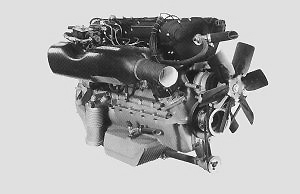 |
| ENGINE TIPO 60 Years of production: 1959-1960 Straight 4-cyl 1990.2 cc engine DOHC with two valves per cylinder Bore 93.8mm and stroke 72mm Compression ratio 9.8:1 Power output 200bhp @ 7800 rpm Induction system by No 2 Weber 45 DC03 carburettors. |
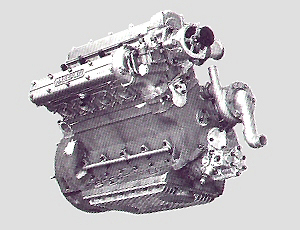 |
|
This engine, mounted in the Tipo 60' Birdcage', was evolved from that of the 200SI. Modifications to the twin-camshaft cylinder head, cast in Electron, were significant with the intake ports and the exhaust ports being reversed. The Tipo 60's low centre of gravity and beautiful aerodynamic shape was made possible by mounting the engine in the chassis at an angle of 45°. For this unusual arrangement it was designed with a triangular sump allowing the sump to be parallel to the road. |
|
|
It was updated as: |
|
| 1959-61 Tipo 61 | 2890.3 cc - 250bhp @ 6800 rpm |
|
To enter Enrico's Maserati Pages CLICK HERE! Copyright: Enrico's Maserati Pages - © 2000-2005. All rights reserved. |